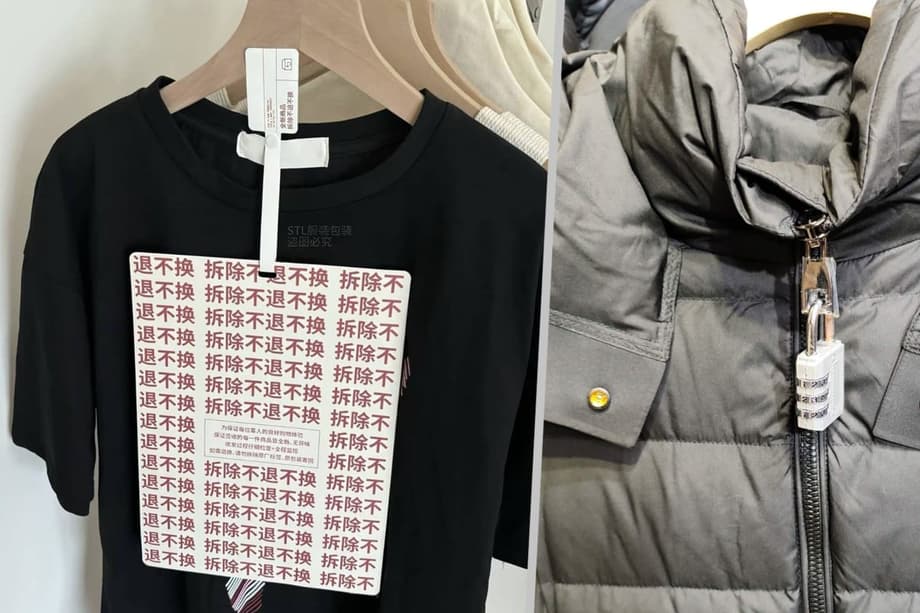A viral deterrent at the height of Double 11
Across China’s fashion ecommerce, large hang tags and even small combination locks are appearing on new garments. Sellers say the extra hardware discourages a subset of customers who wear items once then exploit easy return windows. The tactic, already common in physical stores with security tags, has moved online and went viral during the Double 11 shopping festival (November 11), when order volumes spike.
- A viral deterrent at the height of Double 11
- Why are fashion return rates so high
- How the deterrents work in practice
- Are platforms tightening return rules
- What officials and users are saying
- The cost of returns and why sellers are tougher
- Can technology cut returns without punishing honest buyers
- Legal guardrails and practical tips
- How China compares with other markets
- What to know next
- Key Points
Photos shared on social platforms show stiff cardboard labels the size of A4 paper clipped to sweaters and dresses, printed with messages like “no return or exchange if the tag is removed”. On some winter coats, merchants have fastened a bulky lock to the zipper pull, preventing the garment from being worn in public unless the buyer has the code.
The timing is not accidental. China’s seven day, no reason return rule for online purchases, introduced after a 2014 update to the Consumer Protection Law, makes trying at home simple for shoppers. It also raises costs for sellers who must accept items back if they remain intact. During big shopping events such as Double 11, spikes in returns can turn thin profit sales into losses.
Merchants frame the move as a targeted response to haoyangmao (gathering wool), a catchall term for taking advantage of giveaways or loopholes. In fashion, many use the phrase to describe wardrobing, wearing clothes to a dinner, a trip, or a photo shoot, then sending them back for a full refund. Locks and billboard size tags are meant to make that choice socially awkward and practically difficult.
Why are fashion return rates so high
Chinese shoppers embraced buy to try years ago. Size charts vary by brand, and livestream hosts often urge viewers to order two sizes and keep the best fit. Platforms have offered cheap or subsidized return shipping, removing friction. Industry estimates put women’s apparel return rates at 60 percent to 80 percent for some categories, far above categories like electronics.
Wardrobing adds a separate layer. In the age of short videos and social posts, a fresh outfit can feel disposable. Merchants describe returns that arrive with makeup smudges, perfume scent, sweat marks, or pet hair, leaving items hard to resell as new. There have also been headline grabbing cases where students returned costumes in bulk after performances. Each leg of reverse logistics, from inspection to cleaning to repackaging, chips away at margins.
How the deterrents work in practice
The new tags and locks are designed to preserve the legal idea of intact. They make it easy for a seller to see tampering and hard for an abuser to wear the item normally.
Oversized hang tags
Cardboard tags as large as office paper draw the eye, so they cannot be hidden beneath a lapel or tucked into a waistband. Many are brightly colored and stiff, so they jut out if someone tries to conceal them under a jacket. Messages printed on the front are unambiguous, telling buyers that removing the tag means the order can no longer be returned. Manufacturers say demand surged in 2025, with peak orders leading up to Double 11.
Locks on zippers
Coat sellers have taken a more mechanical route. A small, heavy combination lock clamps the zipper, often connecting two pulls so the coat cannot be closed. Buyers receive the code only after they confirm they will keep the item. Without that code, the lock is difficult to remove without visible damage, which would forfeit the return window. For would be abusers, the lock broadcasts the garment is essentially unsellable if worn out of the house.
Retailers say these add ons target a narrow problem and should not affect honest customers. Shoppers can still try the clothing at home to check fit and fabric, then remove the tag or unlock the zipper after deciding to keep it.
Are platforms tightening return rules
Major Chinese platforms have been moving away from broad refund only options. That approach let some buyers get their money back without shipping goods to the seller. Merchants reported widespread abuse and higher costs, and platforms responded by scaling those programs down. Today, in most cases buyers need to send goods back to receive a refund.
The seven day, no reason rule remains the default for online orders that are intact, with exceptions for items like custom products or intimate apparel. Stores are using conspicuous tags and locks to show that the product stayed unused during the trial period, keeping it within the spirit of the law. Where sellers choose to add conditions, they need clear disclosures on product pages so buyers are not surprised at checkout.
For shoppers, returns are still possible and generally straightforward for legitimate try ons. The difference is fewer loopholes for people attempting to keep items and recover funds.
What officials and users are saying
State media have signaled support for visible deterrents that do not hinder genuine trial at home. In a commentary, People’s Daily argued that large tags strike a balance between consumer rights and fair dealing.
“The tags do not interfere with genuine customers who just want to try things on, but they effectively block return abusers, without discouraging real potential buyers.”
On short video platforms, many users applaud sellers for protecting shoppers who do play by the rules. One popular comment on Douyin, China’s version of TikTok, voiced a concern that others share.
“It protects the rights of regular consumers, preventing them from buying clothes that someone has worn for six days.”
There is pushback as well. Some customers worry that heavy tags or locks could crease delicate fabrics or make trying on winter coats awkward. Others argue that poorly placed tags could obscure how a dress or jacket drapes, which undermines the point of a try at home policy.
Consumer protection lawyers note that the right to return within seven days does not include the right to use an item extensively. They recommend that buyers photograph tags and any locks before removal to avoid disputes about condition.
The cost of returns and why sellers are tougher
Processing a return is expensive. Retailers pay for inbound shipping, inspection, steaming or cleaning, repackaging, and customer service time. When an item returns slightly worn, the seller may need to sell it at a discount or send it to a liquidator. High return rates erode profit margins even for brands with strong sales growth.
Reverse logistics challenges are not unique to China. Research shows that roughly one in six online orders in the United States is returned each year. Fashion is among the worst categories for size and fit issues. Strategies that reduce false demand, like curbing wardrobing, can save sellers significant costs while creating a more honest marketplace for buyers who want new items.
Retailers also face a smaller but growing risk of returns fraud, where buyers swap in counterfeit items or claim defects that are hard to verify. Authentication is costly, and building airtight systems is difficult. Better deterrents and tighter policies are one way sellers try to keep that risk in check.
Can technology cut returns without punishing honest buyers
Sizing technology is getting better. Brands are adopting virtual try on tools and size recommenders that analyze past purchases and body measurements. Companies that use these tools report higher conversion and fewer returns. For categories like denim or fitted jackets, better sizing guidance can matter more than any hang tag.
Fraud screening is advancing too. Platforms test AI based models to flag unusual patterns, such as repeated last day returns or high rates of defect claims from the same account. Some sellers use tamper evident seals with QR codes, which are hard to replicate and easy to scan during intake. The goal is to deter bad actors while keeping the return experience fast for everyone else.
Recommerce, the resale of apparel, is growing quickly worldwide. That gives merchants a channel to recover value from items that cannot be sold as new. It also raises new challenges for quality control and authenticity, so it is not a simple fix.
Legal guardrails and practical tips
China’s seven day, no reason return policy for online shopping has two main pillars. First, buyers can return an order within the window without stating a reason. Second, the item must be kept intact, including accessories, packaging, and invoices. Sellers can refuse returns if the goods show signs of use that affect secondary sales.
For merchants, the safest approach is to make return conditions clear. Place large tags where they do not damage fabric or block essential fitting, describe them on the product page, and remind buyers in the package insert. Avoid unusual restrictions that could be seen as unfair or misleading.
For shoppers, the best protection is to read the listing carefully, keep packaging and tags intact during the try on, and take photos when opening parcels in case of disputes. If a policy seems unreasonable, buyers can contact platform support and cite the seven day rule.
How China compares with other markets
Retailers in the United States and Europe are rethinking free returns. Many fashion chains now charge a fee for mail returns or limit the free option to in store drop offs. The shift reflects the real cost of processing returns and the strain on margins from years of free and easy policies.
Policy design differs across markets. Studies find that retailers present more lenient, detailed return terms in the United States, where many consumers seek strong protections. In China, return windows can be shorter or conditions stricter, especially for cross border orders that are expensive to ship back. Lenient policies can boost purchase intent by reducing perceived risk, but sellers pay for that comfort.
What to know next
Expect platforms to refine guidance on what counts as fair deterrents. Uniform standards for tag placement, size, and wording could reduce disputes. Better fit tools and clearer sizing charts will chip away at legitimate returns. Data sharing on serial abusers, within privacy bounds, will likely expand.
The core tension is simple. Shoppers want the freedom to try at home without worry. Sellers need protection from wear then return misuse that shifts costs to everyone else. Oversized tags and locks are a blunt instrument, but they show how intense the pressure has become.
Key Points
- Chinese fashion sellers are attaching large hang tags and zipper locks to deter wear then return abuse during the seven day return window.
- The trend spiked during Double 11 and spread widely on Chinese social media.
- Industry estimates put women’s apparel return rates as high as 60 to 80 percent in some categories.
- Major platforms are rolling back refund only options and requiring goods returned for refunds.
- People’s Daily backed visible tags that do not block genuine try at home behavior.
- Retailers face high reverse logistics costs and rising concerns about returns fraud.
- Technology such as virtual try on, size recommenders, tamper seals, and AI screening aims to reduce returns without discouraging honest buyers.
- China’s seven day no reason return policy still applies if goods remain intact, so tags and locks focus on preserving that condition.











